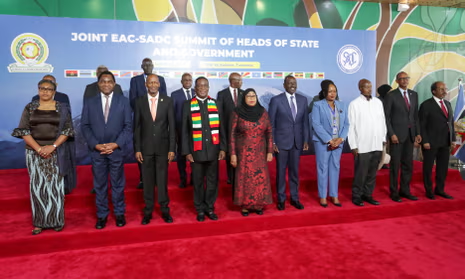The resurgence of the Movement (M23) in the eastern Democratic Republic of the Congo (DRC) has raised significant concerns about the AU’s ability to silence the guns as part of agenda 2063. The M23, a Tutsi-led rebel group, has launched renewed offensives, capturing key territories in eastern DRC.
This development has created a new humanitarian situation, with over 500,000 people currently displaced in a region and continent already dealing with several conflicts with cross-border implications. It has also sparked international furry with reports emerging that war crime tribunals are closely monitoring the situation in DRC.
The situation has further escalated tensions between DRC and its neighbours, particularly Rwanda, whom Kinshasa accuses of supporting the rebel group.
The March 23 Movement (M23) is a rebel group that emerged in the eastern Democratic Republic of the Congo (DRC) in 2012.
It was formed by former members of the National Congress for the Defense of the People (CNDP), a Tutsi-led militia that had been integrated into the Congolese army (FARDC) as part of a 2009 peace agreement. The rebels claimed that the DRC government failed to uphold the terms of the agreement, particularly concerning the treatment and integration of CNDP fighters.

It took its name, the M23, from the date of the March 23, 2009, peace deal, which they accused the Congolese government of violating. Led initially by General Bosco Ntaganda and later by Sultani Makenga, the group launched a rebellion in North Kivu province, seizing Goma, the provincial capital, in November 2012.
However, international pressure, particularly from the United Nations (UN) and a joint military effort by the FARDC and UN peacekeepers, led to M23’s defeat in late 2013, forcing its fighters to flee to Uganda and Rwanda. Despite its defeat, M23 has resurged since 2021, escalating tensions in eastern DRC. It is accused of being supported by Rwanda; an allegation Kigali denies.
This article explores the implications of the M23’s capture of eastern DRC on regional peace and security, examining its impact on neighbouring countries and the overall African peace and security agenda. It also briefly explores the African Union (AU) role and the responses of regional powers like Rwanda, Uganda, Burundi, the Eastern African Community (EAC) and the Southern African Development Community (SADC). It also considers potential pathways toward conflict resolution and sustainable peace.
Implications for Peace and Security in Africa
i. Escalation of Regional Tensions
The conflict in eastern DRC has heightened tensions between the DRC and Rwanda, which have a long history of complex and often hostile relations. The DRC government has repeatedly accused Rwanda of backing M23. At the same time, Rwanda, in turn, alleges that the DRC collaborates with the Democratic Forces for the Liberation of Rwanda (FDLR), a Hutu militia with elements linked to the 1994 Rwandan genocide. The involvement of neighbouring countries, including Uganda and Burundi, further complicates the situation. Uganda, which has historical ties to M23, has deployed troops in eastern DRC under the East African Community (EAC) peacekeeping force. Burundi has also sent forces to combat armed groups in the region. This militarisation of the eastern DRC risks creating bipolarity of support in the guise of regional peacekeeping, especially given the historical links and connections between Rwanda and Uganda on the one hand and Burundi and DRC on the other. This militarisation also risks escalating into a broader regional conflict that could potentially draw multiple states and non-state actors into the conflict.
ii. Increased Humanitarian Crisis
The fighting has displaced hundreds of thousands of people, worsening an already dire humanitarian situation. According to the UNHRC, 5.6 million Congolese are internally displaced in the DRC, with over 4 million in the eastern provinces of South Kivu, North Kivu, and Ituri alone. Since the recent surge in the conflict in January, UNICEF estimated that more than 480,000 people have been displaced.
The conflict has also further exacerbated violence against violence against civilians, including mass killing, gender-based sexual violence and other forms of human rights violations. The humanitarian crisis extends beyond DRC’s borders as displaced populations seek refuge in neighbouring Rwanda, Uganda, Burundi, and Kenya, straining country resources. The influx of refugees can lead to further instability, especially if local tensions arise between host communities and displaced persons.
iii. Destabilisation of the Great Lakes Region
The ongoing conflict has broader implications for the stability of the Great Lakes region, which has historically been plagued by armed conflicts, political instability, and ethnic tensions. The M23’s territorial gains could embolden other armed groups operating in the DRC, including the Allied Democratic Forces (ADF), FDLR, and Mai-Mai militias, leading to a resurgence of violent clashes. There is also an ethnic dimension to the conflict, which could be triggered across regional and country lines. Additionally, the conflict risks undermining regional cooperation efforts, particularly within the East African Community (EAC), where member states have differing positions on the crisis. While some, like Kenya, have sought diplomatic engagement, others, like Rwanda and Uganda, are perceived as having direct stakes in the conflict. Rwanda’s relationship with Burundi is well documented, but its relationship with Uganda remains strong. Without careful diplomatic overtures, the region could be polarised into blocs.
iv. Threats to Economic Stability and Development
Beyond the political, security and humanitarian implications, there is also an economic dimension. Eastern DRC is rich in natural resources, including gold, coltan, and tin, crucial to global supply chains, especially in the technology sector. The ongoing conflict has disrupted mining activities, affecting local economies and international markets and could potentially create entry points for the escalation of illegal mining and trafficking in the DRC. Armed groups, including M23, reportedly benefit from illicit mineral trade, which funds their military operations. Therefore, the conflict could heighten the activities of these groups, thereby hindering DRC from benefitting from its resources and perpetuating cycles of poverty and underdevelopment.
The Role of the African Union and Regional Powers
The AU has engaged in diplomatic efforts to resolve the crisis, primarily through its Peace and Security Council (PSC) and support to EAC diplomatic effort under the leadership of H.E. Uhuru Kenyatta, former President of the Republic of Kenya and Facilitator of the EAC-led Nairobi Process. Although the DRC withdrew from the EAC-led process due to discontent with its effectiveness, the ECA remains engaged, notwithstanding Kenyans’ displeasure with the DRC’s approach to the EAC effort. On the other hand, SACD has taken a more direct approach by deploying military force to eastern DRC. This involvement of SACD has not been fully welcomed by all parties, especially Rwanda, and this has caused tension between Rwanda and South Africa and could lead to a severed diplomatic relationship. In the emergency meeting of the EAC Heads of State on 29 January, Rwanda President Paul Kagame accused South Africa of fuelling the conflict under the pretence of peacemaking, signalling a new form of political and diplomatic confrontation between South Africa and Rwanda. There are also concerns about coordination and the risk of conflicting mandates between EAC and SADC-led processes.
Despite its recent demand for all armed groups, such as M23, ADF and FDLR, to seize fire, the call for resumption of the Luanda Process under the facilitation of H.E. João Manuel Lourenço, President of the Republic of Angola, the Chair of ICGLR and AU Champion for Peace and Reconciliation, and also the resumption of the Nairobi Process, the situation in the region remains the same . The AU peace process appears confusing and contradictory with the involvement of several RECs without clear coordination between the RECs involved. Finding ways to coordinate the responses and involvements of all the interested RECS and member states remains critical. It should be central to the next African Union Summit on February 17–18, 2025, in Addis Ababa, Ethiopia. The outcome of the discussion on DRC at the next summit would determine the momentum of the AU in pushing for a mediative approach that would recognise the root causes of the conflict while advocating for a gradual yet agreeable framework that would end the conflict in perpetuity. The failure to enforce peace agreements and demobilise combatants reflects broader shortcomings in continental and regional conflict management, raising questions about the effectiveness of AU-led initiatives through the African Peace and Security Architecture (APSA).
Conclusion
The capture of eastern DRC by M23 rebels poses a significant challenge to peace and security in Africa. It has escalated regional tensions, deepened humanitarian crises, and exposed the limitations of African-led conflict resolution mechanisms. The African Union, EAC, SADC, and key regional players must adopt a coordinated and decisive approach to restore stability. Without a comprehensive and inclusive peace process, the cycle of violence in the DRC risks undermining broader efforts toward African unity and sustainable development.


